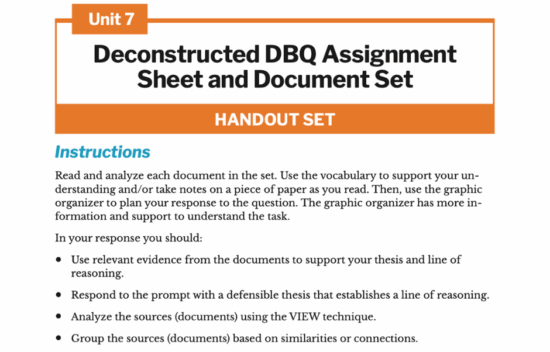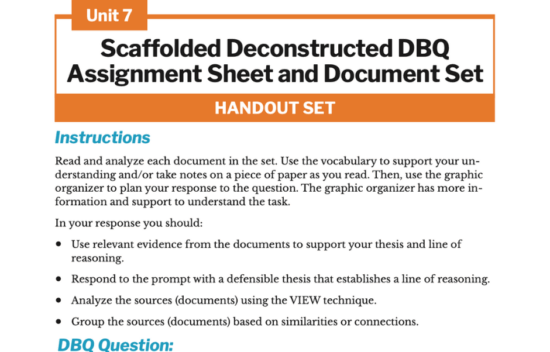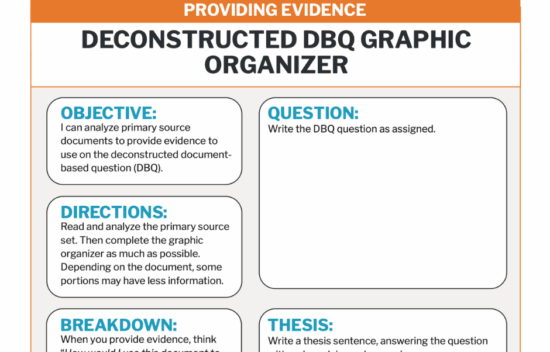
Unit 7: American Expansion Deconstructed DBQ
Lesson Components
Guiding Question
- How did the drive for territorial expansion shape the nation’s identity and create new challenges for the United States?
Objectives
- Students will provide evidence drawn from primary sources to support a specific thesis.
- Students will provide historical context for primary source documents.
- Students will engage in critical thinking to interpret historical perspectives using VIEW (Voice, Intent, Environment, Who).
- Students will develop a thesis statement using historical evidence.
- Students will group sources based on similarities and historical themes.
Student Materials
- Document Set (choose 1)
- Deconstructed DBQ Assignment Sheet and Document Set
- Scaffolded Deconstructed DBQ Assignment Sheet and Document Set
- Documents contained with both sets include:
- Document A: Interview with Harriet Scott Palmer (1939)
- Document B: American Progress by John Gast (1872)
- Document C: Excerpt from the Gadsden Treaty (1853)
- Document D: Excerpt from the Indian Removal Act (1830)
- Document E: Handbill from the California Emigration Society, Boston (1856)
- Document F: Excerpt from President James Polk’s Message to Congress (1845)
- Document G: Alexis de Tocqueville, Democracy in America (1848)
- Documents contained with both sets include:
- Providing Evidence Deconstructed DBQ Graphic Organizer
- Chart Paper for Providing Evidence Placemat
Teacher Materials
- Unit 7 Slide Deck
- Unit 7 Deconstructed DBQ Document Set and Teacher Context
- Unit 7 Model Organizer and Scoring Guide
Teacher note: There are two versions of the deconstructed DBQ documents. The original version includes light scaffolding and is intended for assessment. The second version is more scaffolded and is intended for using the deconstructed DBQ as a learning activity. The two versions can also be used for different levels of learners in the same class.
Facilitation Notes
- This mini-lesson introduces the skill of providing evidence.
- This mini-lesson is intended to take 45-60 minutes and focus on a specific skill. It was created to accompany the mini-lesson teacher slide deck.
- This lesson was created to build upon the previous Deconstructed DBQ lessons. However, it can be implemented in isolation with additional support. Modify the lesson by using the scaffolding notes to fit your classroom.
Anticipate (Optional)
Deconstructed DBQ skill Video Intro
- Assign, or watch as a whole group, the supplementary Deconstructed DBQ skill video for the unit.
- The video will introduce a new primary source from the time period, give historical context and analysis, and then lead students through using the source to answer the Deconstructed DBQ question with a thesis statement.
- Pause the video at the processing questions embedded in the video to prompt reflection and discussion.
Teacher Note: The Deconstructed DBQ videos work as a pre-teaching tool, but can also be used as a scaffolding support later in the mini-lesson. The video is based on a source not included in the Deconstructed DBQ document set, so that the video can be used as a resource in classrooms using the DBQ for skills building, assessment, or both.
Engage
Introduce the Deconstructed DBQ
- Refer to the DBQ question posted on a slide or the board. Tell students: “Today we will investigate how the drive for territorial expansion shaped the nation’s identity and created new challenges for the United States by working with primary source excerpts.”
- Distribute the deconstructed DBQ document set and allow students 10-15 minutes to read, annotate independently, and then ask any questions they may have.
Scaffolding note: There are 7 documents in this primary source set. Scale the set to fit the needs of your students. 3-4 documents is a good place to start.
Teacher note: There are slides in the teacher deck to facilitate a whole-group discussion or reading if your students need more support. There is historical context and more teacher assistance in the DBQ teacher resource document.
Explore
Providing Evidence Placemats
- Transition: Arrange students into groups of four seated around a table. Students should all be facing the center of the table. Distribute chart paper and markers for placemat creation in the center of each group.
- Instruct students to work together to create a Providing Evidence Placemat on the chart paper in the middle of the table.
- A model and instructions are provided in the teacher slide deck for reference.
- Display the Possible Support Details from Primary Sources slide from the teacher slide deck, or create a list on the board of possible supporting details that could be used to answer the Deconstructed DBQ question.
- Each group of students will choose an item from the list and write it in the center of their placemat. Then each student finds a piece of evidence (a quote, summary, or interpretation of art) to put in their own square of the placemat.
- For example, students might select Manifest Destiny and place that in the center of their placemat.
- They would be looking for quotes from the documents that reflect the belief in Manifest Destiny-the idea that Americans were destined to expand across the continent-and how that belief helped shape a sense of national purpose and identity.
- Student 1 might write: Document B: American Progress by John Gast (1872) – Symbolizes Manifest Destiny with Columbia leading settlers west, representing progress and American ideals.
- Student 2 might write: Document F: President James Polk’s Message to Congress (1845) – The U.S. offered to annex Texas to get more land.
- Student 3 might write: Document E: Handbill from the California Emigration Society (1856) – The lure of gold and other economic opportunities motivated Americans to move westward to strike it rich.
- Student 4 might write: Document C: Excerpt from the Gadsden Treaty (1853) – The U.S. acquired more land to build a railroad to help settlement of new lands.
- When the activity is complete, the group will have compiled four pieces of evidence that can be used to support a detail of a possible thesis.
Teacher note: You could also use the Providing Evidence Placemat activity to assign each student group a source to investigate. In this iteration, students place the name of the source in the middle and then write in their box a piece of evidence that helps answer the question.
Scaffolding note:Challenge students to accompany their evidence with a possible thesis statement or challenge students to complete an evidence placemat on their own.
Optional: Grouping Review
- Transition: Distribute the Providing Evidence Deconstructed DBQ Graphic Organizer, if not already distributed. Supply students with highlighters in multiple colors and a plain piece of paper for color-coding.
- Display the Color-coding and Annotation slide from the slide deck. Then provide students with time to annotate and highlight their copies of the DBQ document set.
- They will color-code the DBQ document set to find connections between the sources. They will record their colors and connections on a plain piece of paper using the slide as a guide.
- Then, students group documents based on shared themes, common attributes, constitutional principles (e.g., separation of powers, individual rights), or any other categories they decide.
- Encourage students to justify their groupings in writing using evidence from the documents. They can build on this in the Providing Evidence portion of the Deconstructed DBQ organizer.
- Sample grouping:
- Manifest Destiny and Economic Growth
- These documents reflect the belief in Manifest Destiny-the idea that Americans were destined to expand across the continent-and how that belief helped shape a sense of national purpose and identity.
- Document B: American Progress by John Gast (1872)
- Document F: President James Polk’s Message to Congress (1845)
- Document E: Handbill from the California Emigration Society (1856)
- Document C: Excerpt from the Gadsden Treaty (1853)
- Conflicts and Challenges of Expansion
- These documents reveal the darker side of territorial expansion, including conflict with Native Americans, displacement, and debates over slavery.
- Document A: Interview with Harriet Scott Palmer (1939)
- Document D: Excerpt from the Indian Removal Act (1830)
- Document G: Alexis de Tocqueville, Democracy in America (1848)
- Manifest Destiny and Economic Growth
Optional: Providing Context Review
- Tell students: “Context is: The “who, what, when, where, why, and how” of the document. It explains the world around the source, helping the reader understand its significance within the time period. It should also tie the source to the DBQ question.”
- Students use the history they have learned in the unit to place the source groups in their historical context in the far-right box of the Providing Evidence organizer.
- Context could be key events that occurred before the source, social or cultural climate, economic conditions, political climate, technological developments, notable works of literature, or other things that help explain the significance of the source.
Scaffolding note: If needed, complete one row of the organizer together with your students before releasing them to complete the rest of the organizer independently.
Optional: Document Analysis Using VIEW
- Prompt students to locate the “VIEW”ing the Documents portion of their organizer.
- Use the review slides if needed to refresh students on the purpose of document analysis, provide thought prompts, and preview the organizer.
- Ask them to fill in the E-Environment row of the organizer first, using what they put in the context organizer.
- Then students should fill in at least two more boxes of the organizer for each of their 3-4 documents.
- Some boxes may be empty.
Optional: Thesis Writing & Organizer Completion
- Students use their grouped sources to draft a thesis that answers the guiding question.
- Students write their thesis on the graphic organizer and complete any remaining sections of the Deconstructed DBQ organizer.
Teacher note: Review and example slides are available in the teacher slide deck on hidden slides if re-teaching or specific skill instruction is needed. There are also additional thesis examples in the slide notes.
Scaffolding note: Students needing more of a challenge could be given the opportunity to turn their Deconstructed DBQ into a written response at this stage. This could be a paragraph, or multiple paragraph essay depending on the amount of challenge needed.
Assess
- Students complete their graphic organizer and submit for assessment.
- Collect organizers to assess whether students:
- Provided context surrounding several documents.
- Accurately analyzed sources using VIEW.
- Grouped sources based on logical connections.
- Created a clear, defensible thesis.
Reflect
Peer Review
- Have students share their organizer with a partner.
- Using the prompts from the slide deck, ask students to review their partner’s organizer.
- Ask students to focus on one aspect or review all three depending on your time.
Scaffolding note: The peer review could be completed before students submit their graphic organizers for assessment for a formative assessment.
- Optional Debrief Questions:
- How does analyzing the context surrounding sources help shape your thesis?
- What challenges did you face when grouping the sources?
- How do you create a thesis that answers the question fully, without becoming too long?


